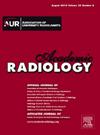甲状腺结节低回声晕的厚度与甲状腺癌之间的关系:一项回顾性研究。
IF 3.8
2区 医学
Q1 RADIOLOGY, NUCLEAR MEDICINE & MEDICAL IMAGING
引用次数: 0
摘要
理由和目的:甲状腺结节患者的低回声晕与甲状腺癌之间的关系仍然是一个有争议的问题。本研究的目的是研究甲状腺结节患者低回声光晕的厚度与甲状腺癌存在之间的潜在相关性。方法:回顾性分析2019年1月至2022年12月320例出现低回声晕的甲状腺结节患者。采用单因素和多因素Logistic回归模型,研究低回声光晕厚度与甲状腺癌之间的关系,并对潜在的混杂变量进行调整。通过相互作用和分层分析来评估人口统计学和肿瘤特异性特征(如年龄、性别、光晕厚度、肿瘤大小和肿瘤位置)对光晕厚度与甲状腺癌风险之间关系的影响。结果:在调整多个协变量后,与厚度为0.05的参与者相比,光环厚度≥1 mm的参与者患甲状腺癌的比值比(ORs)(95%置信区间(CIs))为3.99(2.4-6.62)、3.73(2.09-6.67)和3.16(1.61-6.19)。结节低回声光晕诊断甲状腺癌的曲线下面积(AUC)为0.821 (95% CI: 0.774-0.868),在厚度临界值为1.29 mm时灵敏度和特异性最高。结论:我们对成人的单中心研究显示光晕厚度与甲状腺癌风险呈正相关,表明光晕厚度可能是甲状腺癌发病率的一个有价值的预测指标。本文章由计算机程序翻译,如有差异,请以英文原文为准。
The Association Between the Thickness of the Hypoechoic Halo of Thyroid Nodules and Thyroid Cancer: A Retrospective Study
Rationale and Objectives
The association between hypoechoic halos and thyroid cancer in patients with thyroid nodules remains a contentious issue. The objective of this study was to examine the potential correlation between the thickness of hypoechoic halos and the presence of thyroid cancer in individuals with thyroid nodules.
Methods
The study retrospectively analyzed a cohort of 320 patients with thyroid nodules presenting hypoechoic halos from January 2019 to December 2022. Logistic regression models, both univariate and multivariate, were applied to investigate the association between hypoechoic halo thickness and thyroid cancer, with adjustments for potential confounding variables. Interaction and stratified analyses were conducted to assess the influence of demographic and tumor-specific characteristics, such as age, sex, halo thickness, tumor size, and tumor location, on the relationship between halo thickness and thyroid cancer risk.
Results
After adjusting for multiple covariates, the odds ratios (ORs) (95% confidence intervals (CIs)) of thyroid cancer for participants with a halo thickness ≥1 mm were 3.99 (2.4–6.62), 3.73 (2.09–6.67), and 3.16 (1.61–6.19), compared to those with a thickness <1 mm. The association between thyroid cancer and the thickness of the halo remained stable across different subgroups (all P for interaction > 0.05). The area under the curve (AUC) for the hypoechoic halo in nodules for diagnosing thyroid cancer was 0.821 (95% CI: 0.774–0.868), with the highest sensitivity and specificity observed at a thickness cutoff value of 1.29 mm.
Conclusion
Our single-center study on adults reveals a positive correlation between halo thickness and thyroid cancer risk, indicating that halo thickness may potentially serve as a valuable predictor for thyroid cancer incidence.
求助全文
通过发布文献求助,成功后即可免费获取论文全文。
去求助
来源期刊

Academic Radiology
医学-核医学
CiteScore
7.60
自引率
10.40%
发文量
432
审稿时长
18 days
期刊介绍:
Academic Radiology publishes original reports of clinical and laboratory investigations in diagnostic imaging, the diagnostic use of radioactive isotopes, computed tomography, positron emission tomography, magnetic resonance imaging, ultrasound, digital subtraction angiography, image-guided interventions and related techniques. It also includes brief technical reports describing original observations, techniques, and instrumental developments; state-of-the-art reports on clinical issues, new technology and other topics of current medical importance; meta-analyses; scientific studies and opinions on radiologic education; and letters to the Editor.
 求助内容:
求助内容: 应助结果提醒方式:
应助结果提醒方式:


